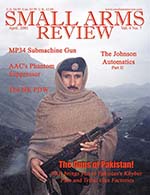SITREP: April 2001
By Dan Shea
After several Clinton years of a massive amount of problems with importing machine guns for dealer sales samples - continually lost Form 6s, State Department stonewalling, etc, the boom has come down now at Imports Branch ATF. All of the large importers are reporting the same problem that the smaller importers have been experiencing- reduction of samples to one per dealer, letters from different departments requesting a demo being required for multiple sales samples. Business has virtually gone into limbo. How can HK, or FN, or SIG function if they can’t get enough sales samples to do demos? How can the dealers function if they can’t get at least two into their inventory? You need a main gun and a backup for a small demo, let alone a hands on demo with 20 or 30 officers live firing for a test. What if your main gun goes down? There is nothing that will blow a sale faster than a product problem where the demonstrator has to fiddle around with a cranky firearm. You need two to do a smooth demonstration. Dealers also need a variety of comparative firearms in order to make sales to departments. Departments also use our services for familiarity, training and forensic evaluation.
We can’t sell from pretty color brochures like a shoe salesman can, we have to get “hands on” with the end users.
Now, apparently due to the recent arrest of a high profile Class 3 dealer who was a felon, who as a corollary had a massive amount of post 86 dealer samples, NFA Branch is instituting similar policies on transfers. Additionally, they are adding a policy where they won’t transfer post 86 machine guns from a law enforcement agency to a dealer’s inventory if the dealer would have more than one of a model that is involved. This means a department trying to trade in their 20 MP5s for new UMP40s would not be able to do so, unless the dealer transferred them out one or two at a time when he found buyers who didn’t have samples, or found another department or group of departments that want the firearms. Show me a department that wants to go along with that circus sideshow.
I am having a lot of trouble understanding the policy here, and how it suits the needs of the law enforcement agencies and Special Occupational Taxpayers involved. What possible reason is there that a Class 3 Special Occupational Taxpayer, can’t inventory 20 MP5s out of a police trade in. These firearms are heavily restricted and have to stay in the SOT/ LE community, so what possible difference does it make where they are stored at.
The only casualties here are the ability of those of us in the business to do business, and the Law Enforcement community to get the service they need. Put the Class 3s out of the LE business, and LE in the United States suffers.
My anthem as a Class 2 manufacturer and Class 3 dealer has always been that we are licensed businesses that pay a Special Occupational Tax to deal in Title II firearms. Why in the hell can’t we do our jobs? Because we might end up with collections of interesting firearms? Of course we will, we have to have them as working reference collections, and we wouldn’t be in the business if we didn’t like guns. If the guns are post 86 dealer samples, then according to the ATF we can only possess them as long as we are Special Occupational Taxpayers. OK, so on ending SOT status we get rid of them.
My point? I firmly believe that the ATF should allow us to do the business that we pay a tax to do, and that includes inventorying guns for resale, and taking trades from law enforcement agencies without having to get demo letters from other departments. If they want to apply some yardstick to see if a dealer is “Engaged in the business” or simply “Engaged in collecting”, let’s see what the yardstick is. In the meantime, we need to address the problems here. There is an old saying that exceptions make bad rules- and I think it is high time for ATF to start looking at the dealers in a good light, and dealing with problems individually instead of hamstringing the whole SOT / LE community because of a few exceptions.
-Dan
This article first appeared in Small Arms Review V4N7 (April 2001) |
| SUBSCRIBER COMMENT AREA |
Comments have not been generated for this article.



